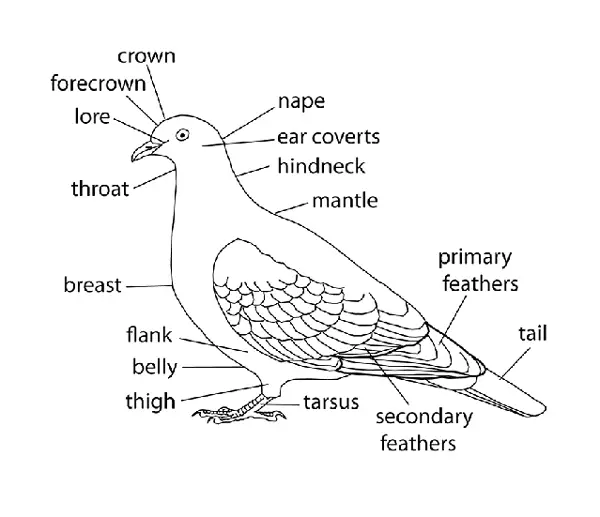Pigeon Ears: Exploring Their Unique Anatomy and Hearing Abilities
Welcome to my article about pigeon ears! You may be surprised to learn that pigeons actually have ears, and they play a crucial role in their daily lives. These fascinating creatures have a unique auditory system that allows them to navigate their surroundings and communicate with one another. In this article, I’ll delve into the world of pigeon ears, exploring their anatomy, functions, and the incredible abilities they provide these birds. So, let’s dive in and discover the hidden wonders of pigeon ears!
When we think of pigeons, we often associate them with their cooing sounds or their impressive flying skills. However, their ears are an often overlooked aspect of their biology. Pigeons possess a remarkable sense of hearing, which enables them to detect sounds that are beyond the range of human hearing. In fact, their auditory abilities are so finely tuned that they can even hear infrasound, which is sound waves below the frequency range of human perception. So, join me as we unravel the mysteries of pigeon ears and uncover the secrets behind their extraordinary auditory prowess.
Anatomy of Pigeon Ears
As a blogger, I find it fascinating to explore the intricate details of different organisms. Today, I want to delve into the anatomy of pigeon ears, which plays a crucial role in their daily lives. Pigeons may seem like ordinary birds to some, but their auditory system is far from ordinary.
One unique feature that sets pigeon ears apart is their location. Unlike humans, who have ears on the sides of their heads, pigeons have their ears concealed within the feathers on the sides of their heads. These hidden ears allow them to navigate their surroundings without drawing much attention.

The ears of pigeons are small, with a structure designed for optimal hearing. Did you know that pigeons can hear a wider range of frequencies than humans? While humans can hear sounds between 20 Hz and 20,000 Hz, pigeons have a hearing range of 1 Hz to 40,000 Hz! This incredible hearing ability helps them detect sounds that are beyond our range of perception.
Pigeon ears also have another remarkable feature: they can detect infrasound. Infrasound refers to sounds that are below the range of human hearing, typically below 20 Hz. Pigeons can pick up on these low-frequency vibrations, which can be useful for them in various ways, such as detecting approaching storms or earthquakes.
The inner structure of pigeon ears is also worth exploring. Like humans, pigeons have three major parts: the outer ear, the middle ear, and the inner ear. The outer ear is responsible for collecting sound waves, while the middle ear amplifies and transmits these sounds to the inner ear. The inner ear contains the cochlea, a spiral-shaped organ that converts sound vibrations into electrical signals that the brain can interpret.
Understanding the anatomy of pigeon ears gives us a glimpse into the incredible abilities of these birds. Their hearing range and sensitivity to infrasound are truly remarkable. By studying the unique auditory system of pigeons, we gain a deeper appreciation for the wonders of nature and the diversity of life.
How Pigeons Hear Sound
Pigeons have a remarkable ability to hear sounds that are beyond our human range. Their ears are located within the feathers on the sides of their heads, allowing them to hear without drawing attention. Let’s explore how pigeons hear sound and what makes their auditory system unique.

Wide Hearing Range
Pigeons have a wider hearing range than humans. While we can hear sounds between approximately 20 Hz to 20,000 Hz, pigeons can detect sounds from an astonishingly low 1 Hz all the way up to 40,000 Hz! This means that they are able to pick up on a wide range of frequencies that are inaudible to us.
Detecting Infrasound
In addition to their broad hearing range, pigeons can also pick up on infrasound. Infrasound refers to low-frequency sounds that are below the range of human hearing. These sounds can be produced by natural phenomena like earthquakes or by animals like elephants. Pigeons’ ability to detect infrasound allows them to pick up on subtle changes in their environment that may be crucial for their survival.
Inner Ear Structure
The inner structure of the pigeon’s ear plays a crucial role in converting sound vibrations into electrical signals for the brain to interpret. It consists of three main parts: the outer ear, the middle ear, and the inner ear.
- Outer Ear: The outer ear, also known as the auricle, collects and channels sound waves towards the middle ear.
- Middle Ear: The middle ear contains the eardrum (tympanic membrane) and three tiny bones called ossicles. These bones amplify and transmit sound vibrations from the eardrum to the inner ear.
- Inner Ear: The inner ear consists of the cochlea, a spiral-shaped organ. Inside the cochlea, tiny hair cells convert the vibrations into electrical signals that are sent to the brain through the auditory nerve.
Studying the auditory system of pigeons not only helps us understand their unique abilities but also provides valuable insights into the diversity of life and the wonders of nature.
The Role of Pigeon Ears in Navigation
In addition to their impressive hearing range, pigeon ears play a crucial role in navigation for these remarkable birds. Let’s dive deeper into how their ears aid them in finding their way.

1. Sound Cues for Orientation
Pigeons rely on sound cues to navigate and maintain their sense of direction. The sounds of wind, flowing water, and even traffic serve as important auditory landmarks for these birds. Pigeons use these cues to create a mental map of their surroundings, allowing them to make accurate judgments about their location and route.
2. Homing Instinct and Acoustic Mapping
Pigeons possess a remarkable homing instinct that helps them find their way back to their nests even when released at unfamiliar locations. This ability is due in part to their acute sense of hearing. By using sound cues, pigeons are able to create an acoustic map in their minds, allowing them to navigate and orient themselves with remarkable accuracy.
3. Detection of Low-Frequency Sounds
One of the extraordinary features of pigeon ears is their ability to detect infrasound, which refers to sounds below the range of human hearing. Pigeons can perceive these low-frequency sounds, such as distant thunder or the beating of wings from large predatory birds. This exceptional ability helps pigeons avoid potential dangers and make informed decisions while in flight.
4. Filtering out Distractions
Pigeons have a unique adaptation in their ears that allows them to filter out distracting sounds. This adaptive mechanism enables them to focus on relevant auditory cues while ignoring irrelevant background noise. This enhanced filtering ability allows pigeons to maintain their navigational focus, even in busy and noisy urban environments.
Understanding the role of pigeon ears in navigation gives us a glimpse into their extraordinary capabilities as aviators. From using sound cues for orientation to discerning low-frequency sounds and filtering out distractions, pigeon ears are marvels of nature’s design.
By studying the auditory system of pigeons, we gain a deeper appreciation for the diversity and complexity of life on our planet. It is a testament to the remarkable adaptability and survival strategies that have been honed over millions of years of evolution.
Communication through Pigeon Ears
Pigeons have a unique way of communicating with each other through their remarkable ears. Let’s delve into how these incredible birds use their ears to communicate and navigate their surroundings.

1. Sound Cues for Orientation
Pigeons rely on sound cues to orient themselves in their environment. They use the subtle sounds of wind, water, and even traffic to determine their location and navigate their way home. These sound cues serve as important landmarks for the birds, assisting them in finding their way, even over long distances.
2. Mental Maps Using Sound Cues
Pigeons have the ability to create mental maps using sound cues. They can remember and associate specific sounds with different locations. By listening to familiar sounds, pigeons can accurately navigate and find their way back to specific feeding areas or roosting spots.
3. Detecting Low-Frequency Sounds
One of the most impressive abilities of pigeon ears is their capability to detect low-frequency sounds, such as infrasound. Infrasound refers to sounds below the range of human hearing. Pigeons can pick up on these low-frequency sounds, which are often produced by natural phenomena like earthquakes or severe weather events. This sensitivity to infrasound allows pigeons to sense imminent changes in their environment and react accordingly.
4. Filtering Out Distractions
Pigeons have an incredible ability to filter out distractions and focus on the sounds that matter to them. They can block out background noise and hone in on specific sounds that are relevant to their survival, such as the calls of their flock mates or the distant sound of potential predators. This keen sense of auditory focus helps pigeons stay alert and safe in their surroundings.
By understanding how pigeons use their ears to communicate and navigate, we gain a deeper appreciation for the remarkable abilities of these birds. Their auditory system plays a crucial role in their survival and adaptation to various environments.
Stay tuned as we explore further fascinating aspects of pigeon ears and their impact on their lives.
Conclusion
The anatomy and unique features of pigeon ears make them fascinating subjects of study. Located within the feathers on the sides of their heads, pigeon ears allow them to navigate their surroundings without drawing attention. With a wider hearing range than humans, pigeons can detect sounds from 1 Hz to 40,000 Hz, including infrasound. Understanding the inner structure of pigeon ears, including the outer ear, middle ear, and inner ear, helps us appreciate the complexity of their auditory system.
Pigeons rely on their ears for navigation, using sound cues for orientation and creating mental maps. Their ability to detect low-frequency sounds, such as infrasound, gives them an advantage in detecting distant dangers or locating food sources. Additionally, pigeons have the remarkable ability to filter out distractions and focus on relevant sounds.
Studying the auditory system of pigeons not only deepens our understanding of their unique abilities but also highlights the diversity of life and the wonders of nature. By appreciating the remarkable adaptations of pigeons, we gain a greater appreciation for the intricate complexities of the natural world.






